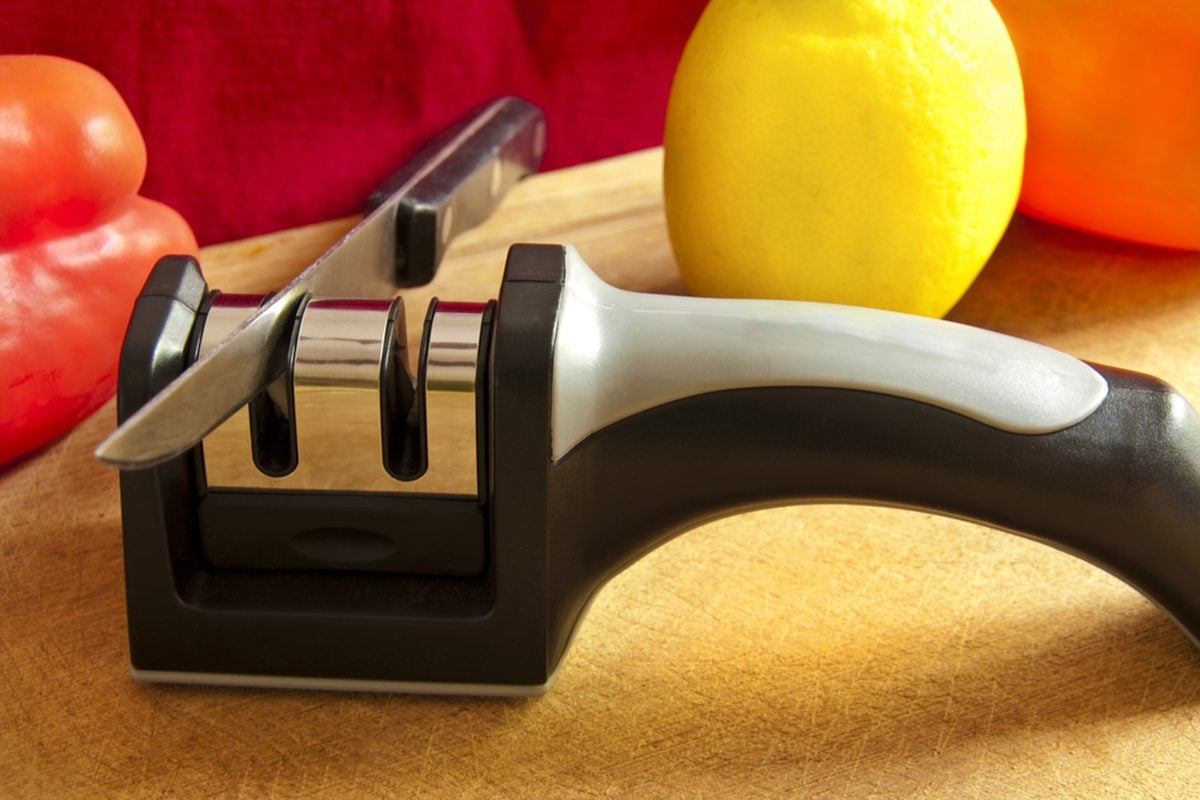One of the first things we learned in culinary school was how to sharpen our knives. We all felt silly running our razor-sharp, fresh-out-of-the-box knives along the whetstone’s granulated edge. But, learning how to keep our knives sharp was an important lesson to learn. After all, a dull knife is a dangerous knife! Here are the ways you could be abusing your kitchen knives without knowing it.
There are a ton of different sharpeners available on the market. While all of them will sharpen your knives, some of them will do it more quickly and efficiently. Which one is the right one for you? Take a peek at our knife sharpener buying guide, where we break down the details between the different knife sharpeners to help you find the best kind for your kitchen.
Types of Knife Sharpeners
Whetstones
Often called oilstones or Japanese waterstones, whetstones are gritty, rectangular stones use water or oil to activate the sharpening surface. Some people prefer the synthetic surface of the Japanese waterstones (myself included) while others prefer the natural stone used for oilstones. They both work by sharpening the existing edge on your knife instead of carving out a new one. To use these stones, you need to hold your knife at the correct angle as you run it down the stone. It can take several passes over the stone before your knife is completely sharp.
Check out this 5-star sharpening stone from Smart Pebble ($40).
Manual and Electric Sharpeners
Unlike the stones, these sharpeners use a V-shaped notch to actually carve a new edge into your steel. You’ll also find table-top electric sharpeners that use a rotating wheel to grind the new edge. They’re super quick and efficient because they only require a few passes through the sharpener. And, because the angle is set for most of them, you don’t need to worry about holding the knife the right way.
This compact manual knife sharpener from Chef’s Choice ($40) won’t take up much space in the kitchen.
Honing Steel
This isn’t actually a sharpener at all. A honing steel is a long rod, sometimes coated in a ceramic finish. Passing a knife on either side of the rod helps to straighten a bent blade without chipping away at the metal. (And a straight blade means better slicing!) If you have very expensive knives, you should definitely own a steel to keep your blade on the straight and narrow between sharpenings. It only takes a few seconds to run the knife along the rod, so most professional chefs use their honing steel every day.
Try this 12-in. honing steel from Utopia Kitchen ($30).
What to Consider Before Buying a Knife Sharpener
Grit
Regardless of the type, all knife sharpeners come in various levels of grit. Most stones are double-sided, and the manual and electric sharpeners often have at least two settings. The level of grit depends on how much metal is taken off of the knife during the course of sharpening. A coarse grit (also labeled as less than 1000 for Japanese waterstones) should be used on a damaged knife that has nicks or chips. Medium grit (labeled as 1000 to 3000 grit) is used to sharpen dull knives that aren’t damaged. Finally, fine grit (4000 to 8000) is similar to a honing steel and is used to refine your knife’s edge.
Size
Size is an important consideration when purchasing a knife sharpener. While the size of the sharpener doesn’t affect its ability to sharpen, it will affect how you store it. Do you have storage space for a large electric sharpener? Or, is your kitchen already tight on space? Most of the stones and manual sharpeners are small enough to be stored inside a drawer. Look at the dimensions of the knife sharpener and consider how you’ll store it before making your purchase.
Time
Almost all knife sharpeners will get the job done, but some of them get it done much more quickly than others. As a professional chef, I don’t mind spending 5 minutes per knife running it up and down a whetstone. If that doesn’t sound like fun to you, look for a manual or electric sharpener that only requires a few passes through the sharpener. They’ll get the same job done, just much faster.
Price
Knife sharpeners can run from $10 to $150. Consider your budget and buy the best-rated sharpener in your price range. If you plan to use the sharpener every week or month, you may want to get a higher-end model that’s built for longevity. But, if you’re only using it right before the holidays to get your knives in tip-top shape to carve your Thanksgiving Turkey or Christmas Roast, you probably don’t need a super expensive model.





















